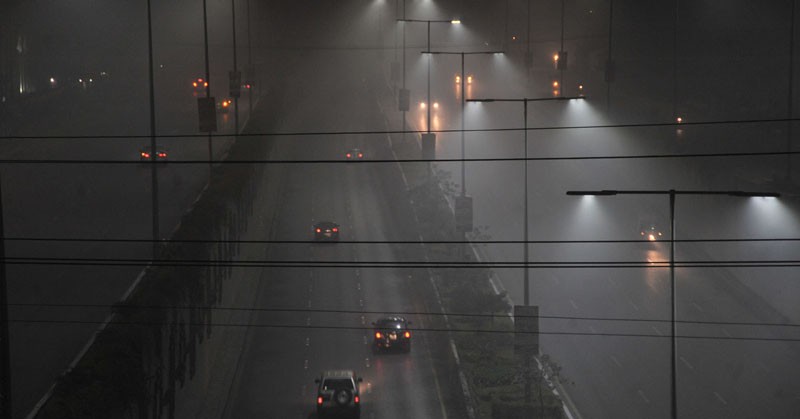
The foggy weeks in Lahore were like as if a sculptor had transformed the town into a Turner-like landscape painting

Dutch novelist, poet and essayist Cees Nooteboom in one of his travelogue books writes: "On my way to Zurich somebody got there ahead of me, a sculptor who also paints and draws. His name is Winter, and he has altered the city I know. His materials are snow, ice, mist, early nightfall, cold, his work takes some getting used to, it is fairly strong stuff."
The same sculptor visited Lahore in the last days of 2014 and the first two weeks of this year and transformed the town in a Turner-like landscape painting. On many a morning, while walking on the streets or driving from one place to other, one noticed familiar surroundings behind layers of grey mist. It seemed like a city under the siege of fog.
Life was suspended and so were communication networks with many people losing their lives in fog-related accidents within the city and other parts of Punjab. Yet one could not stop admiring the visual pleasure it provided. Reality was transformed into art it seemed. The softness of contours and delicate shades of grey not only distracted and made people lose their sense of direction, they introduced an element of art and beauty into ordinary settings.
One could ponder on the idea of joy attached to these misty views. Why does a certain change in temperature and diffused visibility invoke the notion of beauty? How come a peculiar kind of romanticism is associated with these chilly days and cold nights when the media mostly reports bad news?
Perhaps this could be traced to our imbibed idea of an ideal, beautiful and perfect environment. Fog in the subcontinent transforms the local neighbourhood into a European landscape, accentuated by passers-by wearing overcoats, hats, woollen caps, long boots, thick mufflers and gloves. It almost feels as if one is in London, Paris, Berlin or Budapest: a transportation that takes place in fantasy and aspiration.
Along with transposing the local reality to a foreign and desired location, the fog plays a part in mystifying the reality. It’s like being in a dream or inside a delirium. The solid structures, heavy vehicles, concrete buildings and high plazas all melt into soft objects, closer to clouds or fluffy clusters of cotton. The monochromatic views echo the romanticism/nostalgia attached with black & white films and photography. So no matter if it’s due to our colonial hangover or only the excitement of seeing known settings in a picturesque disguise, fog brings pleasure to a lot of people.
This split reaction is seen at another time of the year. During the months of monsoon, torrential rain seems lovely and magnificent to people sitting comfortably in their airconditioned living rooms. They enjoy looking at the greenery submerged in water, overcast sky in dark clouds, and sound of raindrops as if notes of a musical composition are being unfolded. But the same downpour and storm wrecks old structures, mud houses and temporary huts; sometimes burying entire families under fallen roofs.
Yet, monsoon is a greatly awaited and appreciated season. Not only does it bring down temperatures, it transforms the cities into a watercolour painting, bestowing beauty to surroundings that are otherwise considered ordinary. An opinion, not peculiar to artists but shared by the people at large, that somehow reminds one of how the idea of attraction is connected with risk and destruction.
This can be observed in traditional poetry, songs of love and in real life too, where a person has to suffer in order to attain the fruit of his/her heart. It is believed that everything extraordinary and special has to come out of a process of pain. This, in a way, signifies as well as justifies the role of art as a dream or escape from the crude reality to an ideal existence. So to admire the mist in the city without mentioning the loss of lives should not come as a surprise.
In this course of foregoing reality for the sake of art, artists present or embody the most practical (if not the perfect) attitude. To meet the demands of their creative projects and pursuits, they often neglect atrocities of nature, forget human suffering and negate public sentiments. An example of this is Leonardo da Vinci and Michelangelo’s studies of corpses in morgues. Or in common practice a model sits static, sometimes without any clothes in cold weather, in front of an artist who is only keen on painting him/her on canvas. The artists know perfectly well the agony of a person in an unchanging posture, yet they ignore it for reasons of art and aesthetics.
Likewise, subjects which usually disturb ordinary citizens are sometimes picked up by writers and visual artists. Human misery, violence, terror, political turmoil, religious pressure and atrocities of dictatorship are useful (if not inspiring) issues for many individuals in order to create their masterpieces. Occasionally, this course is considered offensive and causes hostility. A recent case of Charlie Hebdo illustrates how the freedom of selecting a subject for artistic expression can come in conflict with matters of faith and disturb a large community.
All these incidents, attitudes and approaches lead to the question of preference between ethics and aesthetics. A sort of choice in an academic sense, because it is hardly a matter of option in our present atmosphere: with overly cast mist of misrepresentation, misunderstanding and misery on the rise and which may not lift in the next season, year, decade or century!